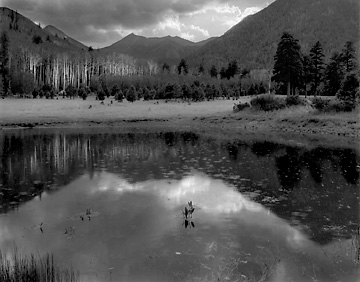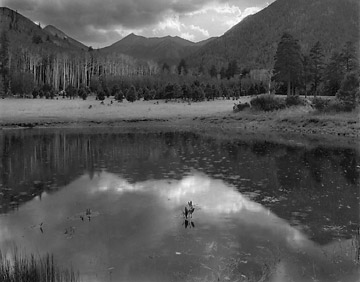
 |
|
Images From Contrast
Masking Workshop Participants
|
|
Roy
Pope
|
 |
|
 |
|
Final Print (after masking)
|
||
|
Lockett Meadow, Arizona.
Copyright © Roy Pope. All rights reserved. This image of Lockett
Meadow, Arizona, is one of my newer images. On my first print I felt that
the bright birch trees did not separate from the surrounding values very
well, and some of the dark trees tended to merge with the background mountains
and other values. I used a Highlight Mask to bring out the diffused birch
trees and rain drop patterns in the pond. I then used a SCIM to separate
the shadow detail in the pond and add shadow density amongst the dark
pine trees. The negative was processed using Lynn's SLIMT approach for
contraction.
e-mail |
||
|
This image is a good example of how masking can be used to selectively enhance various areas of an image without affecting other areas. I like how Roy used a custom highlight mask to affect only the birch trees and raindrop patterns without affecting the bright sky values and mid-tone values at all. His use of a SCIM to enhance the pine trees gave the print a rich and tactile feel and prevented the dark values from going "muddy". Simply resorting to a higher contrast paper would have the unfortunate effect of increasing contrast in the midtones as well, distracting from the essential elements.With the judicious use of masking, Roy produced a very eloquent image. Lynn Radeka |
We worked on Roy's Saguaro image at the October, 2005 workshop. Roy's primary concern was that the clouds were not standing out against the overcast sky. The other concern was that the values were fairly harsh. Resorting to a higher grade paper would help the separation in the sky and cloud areas, but would have an adverse affect on the overall contrast of the image, taking away from the delicate forms of the saguaro. We decided to make a Contrast Reduction Mask, which had two nice effects: it softened the contrast in the cactus and foreground areas creating a more uniform tonal balance, and it enhanced the sharpness of the print. We were then able to make a print on a higher grade paper (about 2 grades higher than the straight print without the mask) which helped separate the clouds against the sky. The dark detail in the print still looked a bit flat and gray as a result of the fairly strong contrast reduction mask, so we made a Shadow Contrast Increase Mask (SCIM) to bump the deep black accents back down to create a rich and tactile feel to the image. Lynn Radeka |
|||||||||